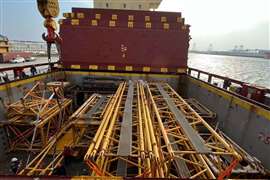The high-efficiency utilities sector
11 April 2013

Manufacturers are focussing on increasing the efficiency of the specialist equipment used to install utilities to help contractors complete work more quickly and cost-effectively. New equipment and techniques are constantly being developed that are uniquely tailored to this sector – a market which is growing around the world as emerging economies mature.
Indeed, Herrenknecht estimates that the global pipeline network, from gas pipes to oil, freshwater, district heating or protection pipes for power cables, is currently expanding by 25,000 km per year – growth that it is keen to capitalise on.
The company was nominated for a Bauma Innovation award for its new semi-trenchless method for installing pipelines – Pipe Express. It claims the new method is both more cost effective and environmentally friendly since earthwork can be reduced by up to -70% compared to the conventional open trench method, and no groundwater lowering along the route is necessary.
The main components of the Pipe Express installation system include a drill that works underground, a trenching unit with a buggy and an operating vehicle on the terrain surface. The drill loosens the soil, which is then directly conveyed aboveground using a milling unit and stored alongside the route.
At the same time, the pipeline is installed underground, with the trenching unit functioning as a vertical connection between the tunnel boring machine and the terrain surface. The thrust force for the pipeline is provided by a Herrennecht Pipe Thruster.
The system is remote controlled from the operating vehicle and no trenches have to be dug. It can be used to install pipelines of up to 1 km long with diameters of 800 mm to 1.5 m
Herrenknecht claims this method is unique in the market, and is well-suited to projects in which the groundwater level is just below the surface, in mainly swampy terrain or when protecting the environment is of special importance.
The company has been testing the technology in the Netherlands, and project manager Andreas Diedrich said it had exceeded all expectations. “The machine works with a speed of up to 1 m per minute, which means that 500 m of pipeline were installed in three days,” he said.
Vermeer has also introduced new pneumatic piercing tools – machines which bore horizontally through soil to install pipes or cables without the need to dig trenches.
The company’s new Hole Hammer piercing tool comes in 2 in (50 mm), 2.5 in (64 mm) or 3 in (76 mm) sizes and features a moving head design that is said to provide full striking force of the piston to the head of the tool, pulverising stones into the surrounding soil. The residual energy is used to help the tool body travel through the compacted bore path. This results in more accuracy in tough soil conditions and reduced tool deflection.
A ribbed tool body also provides additional grip for traction in loose soils, helping achieve forward impact on each blow. This is said to provide for maximum tool power, strong forward thrust and reduced tool swimming for more accurate bores.
Meanwhile, Hammer Head Trenchless Equipment has introduced what it claims is the world’s largest pneumatic pipe ramming hammer – a 34 in (864 mm) hammer that can install casing with diameters ranging from 48 in (1.2 m) to 180 in (4.6 m).
Although the hammer was designed specifically for pipe ramming projects, with custom-built tooling it can also be used for pipe bursting to replace 36 in (914 mm) pipe and larger. Hammer Head said it could provide custom-built accessories upon request.
Hammer Head CEO and president Brian Metcalf said the hammer was designed for challenging projects. “The amount of power generated through our unique design and patented air reverse that allows for forward and reverse from the control station will provide contractors with productivity never before available for installation of large diameter pipe,” he said.
Pipe fusion
Other new equipment specifically targeting the pipelaying sector includes McElroy’s new pipe fusion machine – the Super Trac Star 250. Pipe fusion is a process that joins two pieces of thermoplastic pipe together with heat and pressure to create a continuous, sealed pipeline.
The new model pairs a standard 250 fusion machine carriage for fusing 63 mm to 250 mm polyethylene pipes with a larger tracked chassis powered by diesel fuel. It is a self-propelled, track-mounted vehicle that can handle grades up to 30%.
The new pipe fuser comes after Trac Star introduced its Trac Star 500 Series 3 machine, which is capable of fusing thermoplastic pipes with outer diameters from 180 mm to 500 mm. The machine’s carriage can also be removed and lowered into a ditch for fusions in tight spaces.
Tracto-Technik has also concentrated on the pipe and cable installation sector, and has developed a new 100 tonne cable and pipe pilling winch – the Grundowinch – which is currently undergoing UK trials.
The twin capstan constant tension winch and attendant cable carrying winch are both track-mounted for rough terrain mobility and have front and rear stabilisers for winching stability. Each unit has its own diesel engine of 140 kW and 74 kW respectively, both fitted with independent remote controls.The machine allows 1.5 km of 52 mm diameter steel winch pulling cable to be deployed.
Tracto-Technik will also be introducing new machines at April’s Bauma show in Munich, Germany, including its new Grundoburst pipe replacement machine, which features 1900 kN pulling force for replacing old pipes with new pipes, and its new Grundodrill 18 ACS horizontal directional drilling
(HDD) rig.
Ditch Witch has also introduced new HDD equipment in the form of the JT30 Mach 1 and JT30 All Terrain. It said both drills incorporate extensive customer feedback from years of experience in all types of job conditions, resulting in drills with greater power to all drill functions, more stability, simplicity of operation, and greater overall efficiency.
Each drill is equipped with a 119 kW, Tier 4 Interim-compliant engine, and the All Terrain model boasts an advanced inner rod design that enables it to drill in a wide range of ground conditions, from mixed hard soil to solid rock.
Ditch Witch also paid a lot of attention to the environmental impact of the new HDDs, particularly noise. It claims the new machines are the quietest drills in their class, with a maximum 85 dBA operator sound pressure. This allows them to be operated in urban areas with minimal disruption.
Meanwhile, the manufacturer has also introduced a new trenching machine, which opens up the ground to allow utilities to be laid, in contrast to the HDD method. The Ditch Witch RT80 Quad heavy-duty ride-on trencher and vibratory plow has been designed to be rugged and durable and provide traction on rough and uneven terrain.
The 62 kW RT80 Quad features a three-speed, shift-on-the-fly ground drive and can carry vibratory plow, traversing trencher, saw, or backhoe attachments. Ditch Witch’s described the machine as “ideal for installing utilities in some of the toughest jobsite conditions”.
Vacuum lifting specialist Vacuworx, meanwhile, has released a new attachment – the MC3 – which has been developed for a range of equipment, including excavators, wheeled loaders, forklifts and cranes.
The compact unit uses vacuum suction to lift materials such as steel plates, concrete slabs and pipes up to a 3 tonne capacity.
Only the suction pads need to be changed to switch to different pipe diameters, and the attachment can also be operated by wireless remote control. Vacuworx claims the advantages of using a vacuum lifting attachment include the fact that fewer ground personnel are required, reducing the risk of accidents, while the risk of damage to materials or their coatings as they are being handled is also reduced.
Leak detection
Locating and fixing leaking utilities is also a growing field of development, and Ferret Technology has been busy working on new technology to reduce the time and cost of these projects.
Accurately locating leaks on plastic pipe has historically been a challenge, according to Ferret, as plastic does not transmit leak noise as well as metallic materials do. This limits the potential to use more traditional acoustic-based systems.
The Ferret system uses a hydraulic principle to pinpoint leaks to within millimetres using the existing water pressure in the pipe to drive the unit. An inflatable plug is pushed down the length of the water pipe, acting like a moveable valve and stopping automatically when the plug passes a leak because of the change in pressure.
Richard Ingham, Managing Director of Ferret Technology said the system avoids unnecessary excavations. “The operator can move the plug down the pipe, isolating sections of the pipe at any point just by inflating the plug which acts like a line valve.”
Mr Ingham explained that a small signalling device built into the back of the plug is then activated, and can be located from above ground in order to pinpoint the leak location.
F
erret tested its new technology over 12 months, and found the leak detection system could reliably locate leaks over a range of up to 50 m on plastic, lead and copper pipes of between 10 mm and 50 mm diameter.
Another manufacturer trying to tackle the problem of leaks is E-Z Drill, which has developed a vertical utility drill for pinpointing gas leaks.
Tailor-made for gas utility companies, the 20 UTL is also said to save valuable time and money by allowing companies to find the site of a gas leak without tearing out significant stretches of roadway.
The 20 UTL allows contractors to drill through the road surface in periodic intervals to check for gas. Working this way is said to enable operators to narrow the potential leak area to a stretch between holes that would need to be removed for repair work.
While specialised for the gas utility industry, E-Z Drill said the 20 UTL – which can drill down to 18 in (457 mm) – can handle virtually any type of vertical drilling application.
From the installation of new pipes and cables to the detection and repair of existing facilities, it is clear that manufacturers are concentrating on developing new equipment to service the entire lifetime of utilities. It will be interesting to see how emerging markets tackle the same issues in the future.



